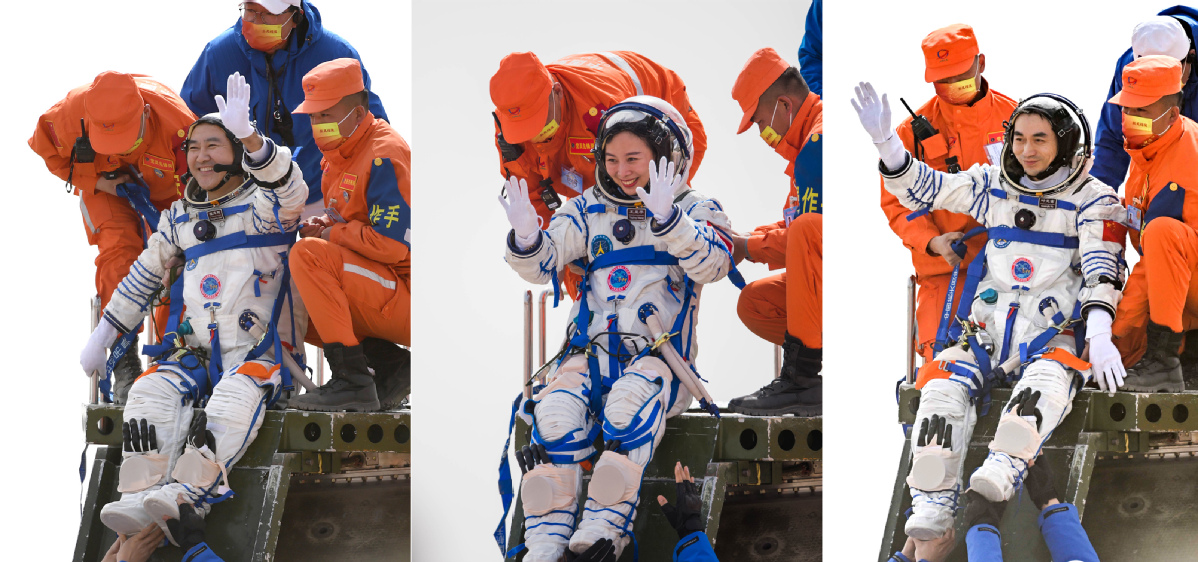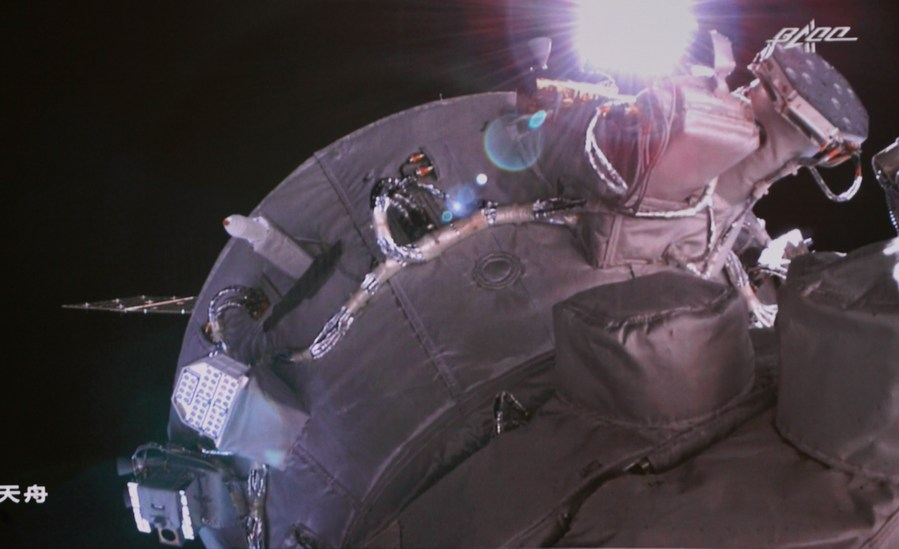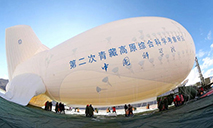China’s space program: achievements and contributions for the shared future of mankind

Chinese astronauts (from left) Zhai Zhigang, Wang Yaping, and Ye Guangfu of the Shenzhou XIII spaceship complete their six-month space station mission, returning to Earth safely on Saturday. The mission sets a record for the duration in orbit of Chinese astronauts. [Photo/Xinhua]
Last Saturday marked yet another important day to showcase to the world the pride and determination of the Chinese people. On that day, China successfully completed its Shenzhou-13 mission, marking several new milestones in the country’s quest for space exploration.
Achievements and future plans
The success of the Shenzhou-13 mission highlights the reality of China's technological breakthroughs and demonstrates the capabilities and utility of its space program.
The three Chinese astronauts completed a six-month mission on the Shenzhou-13 manned spacecraft and landed safely in the Inner Mongolian Autonomous Region of northern China last Saturday. The crew landed only eight hours after the manned spacecraft's detachment from the Tianhe core module. Upon their return, they had successfully completed the nation's longest manned spaceflight.

Zoey Cardamone, a US student who asked China's astronauts aboard the Shenzhou XIII spacecraft a question, shares her insights on Saturday during an event in Washington, DC, that featured a Q&A session between US students and the astronauts. The event was hosted by the Chinese embassy in the United States. SHA HANTING/CHINA NEWS SERVICE
The Shenzhou-13 spacecraft that carried Zhai Zhigang, Wang Yaping and Ye Guangfu was launched by a Long March 2F carrier rocket last October from the Jiuquan Satellite Launch Center in Northwest China's Gobi Desert. From then on, its crew would go on to live and work in the spacestation complex for a total of 183 days. It is almost double the previous record of 92 days set during the Shenzhou-12 mission.
Chinese scientists plan to complete construction of the Tiangong Space Station this year. The China Aerospace Science and Technology Corporation (CASC) has said it plans to launch more than 40 space launches in 2022.
This year, China will launch the Tianzhou-4 cargo spacecraft. After that, it will launch the country’s Shenzhou-14 crewed spaceship. The Tianzhou-4 will be launched to deliver supplies for the Shenzhou-14 crew. During their stay in outerspace, two laboratory modules – namely, Wentian and Mengtian – will be launched into space. At the same time, a number of scientific experiments are being planned for the Tiangong Space Station.

Photo taken on Jan. 6, 2022 at Beijing Aerospace Control Center shows the transposition test of the Tianzhou-2 cargo craft using its space station's robotic arm. (Xinhua/Guo Zhongzheng)
Peaceful purposes
Since 2016, China's aerospace industry has made rapid and innovative progress. China conducts this scientific research while defending the principle of space exploration and its use for peaceful purposes. Meanwhile, China has in many ways helped to promote space science and research in other developing countries. Accordingly, assistance has been provided for the construction of space infrastructure, the training of professionals and the provision of space observation data.
As a developing country, China's current achievements in the field of space research are of paramount importance not only to China but to the entire world. These achievements for China are a contribution to extraordinary human endeavors in the area of space exploration.
China has partnered with other countries in the world to jointly promote the role of space technology in implementing the UN 2030 Agenda, including facilitating the concept of sustainable development. CNSA says that China has signed about 50 space industry cooperation agreements or memorandums of understanding (MoUs) with foreign countries over the past five years.
China has launched an International Lunar Research station project with Russia and has signed cooperation agreements with the BRICS (Brazil, Russia, India, China, and South Africa) for its Remote Sensing Satellite Constellation. The China-France Oceanographic Satellite and the China-Italy Electromagnetic Monitoring Experiment Satellite are just a few of the collaborative projects now underway. Over the past five years, data from China's Gaofen-1 and Gaofen-6 remote sensing satellites have been provided free of charge to 158 countries or regions.

The return capsule of the Shenzhou-13 manned spaceship lands successfully at the Dongfeng landing site in north China's Inner Mongolia Autonomous Region, April 16, 2022. (Xinhua/Peng Yuan)
Open to foreign astronauts
China has already announced that it will welcome foreign astronauts to the Tiangong Space Station. It has been designed to be adaptable to foreign astronauts in order to make greater contributions to the shared future of mankind.
China's space station is the first project of its kind that is open to all UN member states and has already selected nine projects from 17 countries and 23 institutions for research purposes.
Exploration of the unknown universe and the development of space technology would not have been possible without the cooperation of countries around the world. Therefore, the opening of the Chinese spacestation to the world is a good example of the country’s desire to enhance international cooperation in conducting space missions.
The author is a lecturer at the Yunnan University School of Foreign Languages, a former foreign expert for the China Media Group (CMG) Sinhala Service, a senior journalist of Sri Lanka and a published author.
The opinions expressed in this article reflect those of the author, and not necessarily those of People's Daily Online.
Photos
 Colorful carpet of mountain flowers brightens Nanshan Pasture in Xinjiang
Colorful carpet of mountain flowers brightens Nanshan Pasture in Xinjiang China’s central bank to issue commemorative coins on cultural theme of auspiciousness, including two heart-shaped coins
China’s central bank to issue commemorative coins on cultural theme of auspiciousness, including two heart-shaped coins Population of endangered black-headed gulls exceeds 10,000 mark in NE China’s coastal city of Panjin
Population of endangered black-headed gulls exceeds 10,000 mark in NE China’s coastal city of Panjin China's self-developed floating airship breaks record
China's self-developed floating airship breaks record
Related Stories
- China’s space station first to be open to all UN member states: Chinese FM
- China to send next space crew aloft in June
- Welcome home
- China completes engine tests for Long March-5B Y4, marching toward space station lab module launch
- China to improve space infrastructure with new satellites, technologies: white paper
Copyright © 2022 People's Daily Online. All Rights Reserved.






